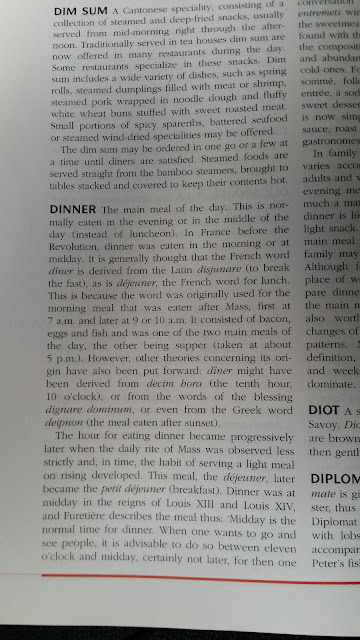I've heard lots of chefs on TV say that their go-to cookbook and reference is Larousse Gastronomique, a huge monster of a book. They use it took reference cooking terms, ingredients, etc. Being that I love reading and perusing cookbooks, and it has to added perk of being THE reference of choice for chefs, I had this book on my list as the next one to obtain, whether it be new or used.
Bob and I went to the library a couple weeks ago so he could get some books on old houses (ours is old--it was built in 1735). I naturally ran right over to the cookbook section to see what I could find. It suddenly dawned on me (see what I did there?) that I should look for Larousse Gastronomique, that way I could browse before I buy.
I started browsing the shelves, thinking that the books are arranged in the same manner as in the book store. I totally forgot I was in a library and the books are arranged according to the Dewey decimal system. I didn't feel like trekking back down to the library's computer so I just looked it up on my phone. I got the number and then found the appropriate section of the shelf. Turned out I was way off in the location; I was in the last aisle and I had to be at the end of the third to last aisle.
At last I found the book! Here it is: it's huge and the cover is colorful.
The book isn't all that pretty inside, though. As the cover says, it's basically an encyclopedia for the culinary arts. And that's how it's set up: entries are in two columns per page, there are very limited photos, and the print is small. Pretty much any ingredient you can think of is listed in the book, although I was surprised that crab apples weren't listed, as they are used in jams and jellies. (I have crab apple trees, so it was potentially pertinent information I could have found, but didn't). As you can see, it even tells you what "dinner" is. If you don't know what dinner is, you probably need more than this book....
The book also contains recipes for most ingredients listed, which are listed at the end of the entry for the ingredient. I really didn't care for the way the recipes are laid out, though. As you can hopefully see here, each recipe is in paragraph form; there's no list of ingredients or steps. It says to cut x ingredient into pieces and then saute in a pan with x amount of butter. Then add x amount of another ingredient, which is to be peeled and sliced. I found it difficult to follow this format and I also don't like that there aren't pictures of the finished product (yes, I know this is for real chefs and they don't need pictures, but I do!). I also found that the recipes are somewhat involved and fussy, but, again, they're geared towards serious chefs.
My overall verdict for this book is that it's a great resource for chefs, but it likely won't be of much use to the typical home cook, unless they're a serious foodie or really want to increase their knowledge. And the retail price of this book is $75.00 (!), so I'm really glad I decided to borrow it from the library!



No comments:
Post a Comment